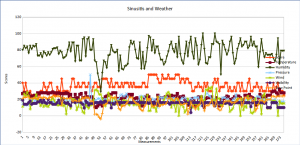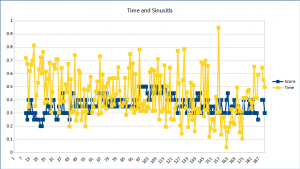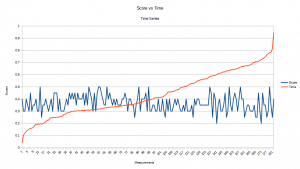Data

Sinus data can assist people in identifying causes, correlations, or patterns in their sinus symptoms. Some ideas of data to analyze include:
- Sinus symptoms
- Weather
- Allergens
- Diet
- Exercise
- Time of day/month/year
- Add your ideas!
Graphs[edit]

We can make graphs of sinusitis symptoms including time series.
Graphs show data in a format that people can easily see. There are numerous graph types, including these line graphs, as well as bar charts, pie graphs, and others. The goal is to make it easy to see associations. This can assist people in discerning what may cause symptoms.
You can document data using standard spreadsheet software, such as the freely available LibreOffice Calc. There are also specific tools for medical symptom data.
Statistics[edit]
In addition to visual graphs, we can also conduct statistical analyses. These apply somewhat comparable techniques to what the mind does anyways, but numerically. For example, we can look for correlations of sinus symptoms with various other events. Alternatively, we can use more advanced statistical techniques like analysis of variance.
Results[edit]
Some results that one individual has noticed thus far from data analysis, which may not apply to other people, indicate that cloudy weather ranks among the main causes of rhinosinusitis, and that wearing these sports glasses works better than other treatments. Details include:
- A negative correlation of sinus symptom intensity with air temperature (-0.31).
- Better sinuses in cooler temperatures.
- A positive correlation of sinus symptom intensity with visibility (0.07).
- Better sinuses on clearer days.
- A negative correlation of sinus symptom intensity with time of day (-0.18).
- Better sinuses early in the day.
- A positive correlation of sinus symptom intensity with air pressure (0.14).
- Better sinuses in high pressure (which correlates with clear days).
- A positive correlation of sinus symptom intensity with humidity (0.02).
- Better sinuses in higher humidity.
- A negative correlation of sinus symptom intensity with wind (-0.09).
- Better sinuses with less wind.
Also, sinus symptoms seem cyclical, as with other biological patterns. There are probably circadian, ultracircadian, and infracircadian rhythms (i.e. with durations of one day, shorter than a day, and longer than a day).
The distributions of sinus symptoms and some weather conditions may be normal.
Many of the above results are highly speculative. For example, the relationship with time may indicate a general pattern of better sinuses later in the day, but sinus scores seem to cycle throughout the day.
Some paranasal sinuses may be more affected by symptoms than others. For example, the ethmoid, maxillary, and frontal sinuses may be more affected than the sphenoid sinuses.
Additional Resources[edit]
Sinusitis is one of the main reasons why people have medical problems or see doctors. National Center for Health Statistics
